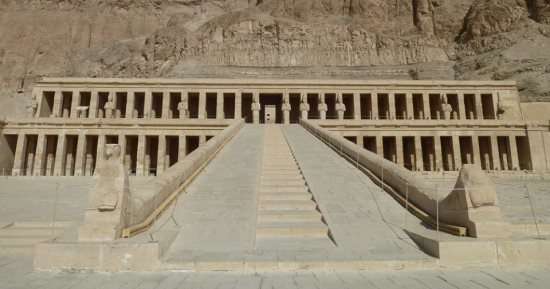From Luxor, head of the Egyptian-Polish mission working at Deir el-Bahari temple and head of the French mission working in Al Madamum area invited the world to visit Egypt and discover its unique archaeological treasures.
In front of the Temple of Queen Hatshepsut in Deir al-Bahari, the head of the Egyptian-Polish mission spoke about the temple, its history and the gorgeous inscriptions that adorned the walls, describing it as the largest and most wonderful archaeological area in the world.
The head stressed the need to visit the temple and discover its wonders.
From Al Madamum, a few kilometers from the north of Karnak, the head of the French mission spoke about the scientific studies that the mission is carrying out and invited the world to visit the area and discover its archaeological treasures.
Hatshepsut Temple:
Queen Hatshepsut (ca. 1473 - 1458 BC), the queen who received the title of Pharaoh, built a funerary temple for her in Deir el-Bahari, which is located on the west bank of Luxor and designed by Senenmut, who bore the title of Chief Steward of Amun.
The temple consists of three levels, each of which contains a colonnade at the end.
On the upper level, an open courtyard lies, which contains statues of Hatshepsut as Osiris, the god of the dead, leaning against its pillars in the back.
The walls are decorated with scenes of the temple rituals, religious holidays and the transfer of obelisks from the quarries to the Karnak Temple.
The most distinctive views, perhaps, are those on the middle balcony, which depicts Hatshepsut's journey to Punt. In addition to the riches and exotic animals, the Egyptians brought with them from there. The scenes also depict how Hatshepsut became the legitimate king of the country.
[caption id="attachment_220977" align="aligncenter" width="716"] Deir el-Bahari temple[/caption]
Deir el-Bahari temple[/caption]
Al Madamum:
The region includes a Ptolemaic temple built by King Ptolemy II, which construction was completed during the reign of King Ptolemy VI. It was dedicated to Montu, his wife and son.
It consists of a monument, courtyard, colonnade and Holy of Holies. The temple features Egyptian, Greek and Roman architectural elements, albeit the first foundations of the temple date back to the Middle Kingdom.
The temple was known in ancient Egyptian texts as "Montu ", which became "Al Madamum" in Arabic.
Contributed by Yara Sameh












